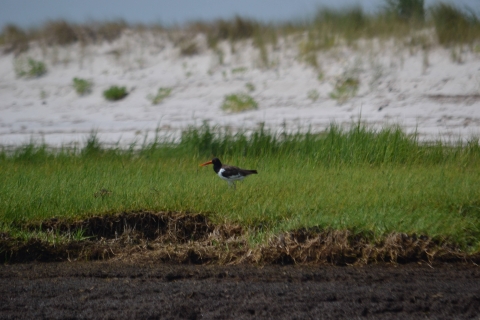About Us
Plum Tree Island National Wildlife Refuge encompasses the largest contiguous salt marsh salt marsh
Salt marshes are found in tidal areas near the coast, where freshwater mixes with saltwater.
Learn more about salt marsh ecosystem in the lower Chesapeake Bay. Located along the Atlantic Flyway, the refuge offers diverse salt marshes, tidal streams, and wooded ridges that support fish, waterfowl, marsh and wading birds, and shorebirds. Serene shorelines offer secluded habitat for breeding and nesting wildlife, including the northern diamondback terrapin.
The refuge offers a rare opportunity for residents and visitors of the Hampton Roads area to safely enjoy expansive views of abundant wildlife thriving in these important, vulnerable, and scarce salt marshes. In partnership with others, the refuge’s wildlife habitats support the rich traditions of hunting, fishing, and boating in the Chesapeake Bay.
Our Mission
We will conserve the coastal estuarine ecosystem to sustain high ecological integrity for the benefit of native flora and fauna, with emphasis on priority refuge resources of concern, within the lower Chesapeake Bay.
We will provide safe wildlife-dependent recreational opportunities for visitors to connect with nature and foster enhanced stewardship of the lower Chesapeake Bay and the Refuge System.
We will cultivate partnerships to further conservation, education, and interpretation of the refuge's natural and cultural resources, as well as the mission of the Refuge System.
Our History
Plum Tree Island NWR overlooks the Chesapeake Bay from a central location between the James River and the York River. Over thousands of years, the availability and variety of natural resources influenced the strategies used by Native Americans in their settlement and land use in this vicinity.
In the late 16th century, the Powhatan chieftainship, which consisted of approximately 30 tribes who spoke the Algonquian language, dominated the Virginia tidewater area. Present-day Plum Tree Island NWR was within Powhatan's sphere of influence and was part of a marshy zone for which the Native Americans used the term "pocosin," meaning swamp on a hill. This term was preserved in the name of the present-day city, Poquoson. Archaeologists estimate that about 75,000 Native Americans occupied the Chesapeake watershed at the time of European contact.
Other Facilities in this Complex
Plum Tree Island National Wildlife Refuge is managed as a part of the Eastern Virginia Rivers National Wildlife Refuge Complex, which is comprised of four different refuges. Please click the links below to learn more about these refuges.

